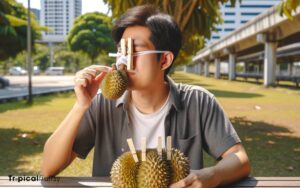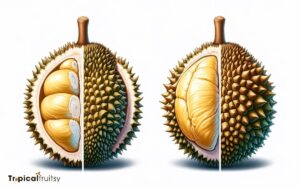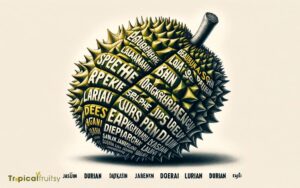D24 Durian Vs Musang King: A Sensational Showdown!
The comparison between D24 and Musang King durians reveals that while both are premium varieties, they have distinct flavors, textures, and market standings.
D24 is known for its creamy texture and bittersweet taste, while Musang King is renowned for its intense flavor and custard-like creaminess.
D24 and Musang King are two of the most sought-after durian varieties, each with unique attributes:
Both varieties differ in terms of flavor, texture, nutritional content, availability, and price, making the choice between them a matter of personal preference and seasonal considerations.
Explore the nuanced differences between the creamy, bittersweet D24 and the rich, complex Musang King to discover your preferred durian delight.
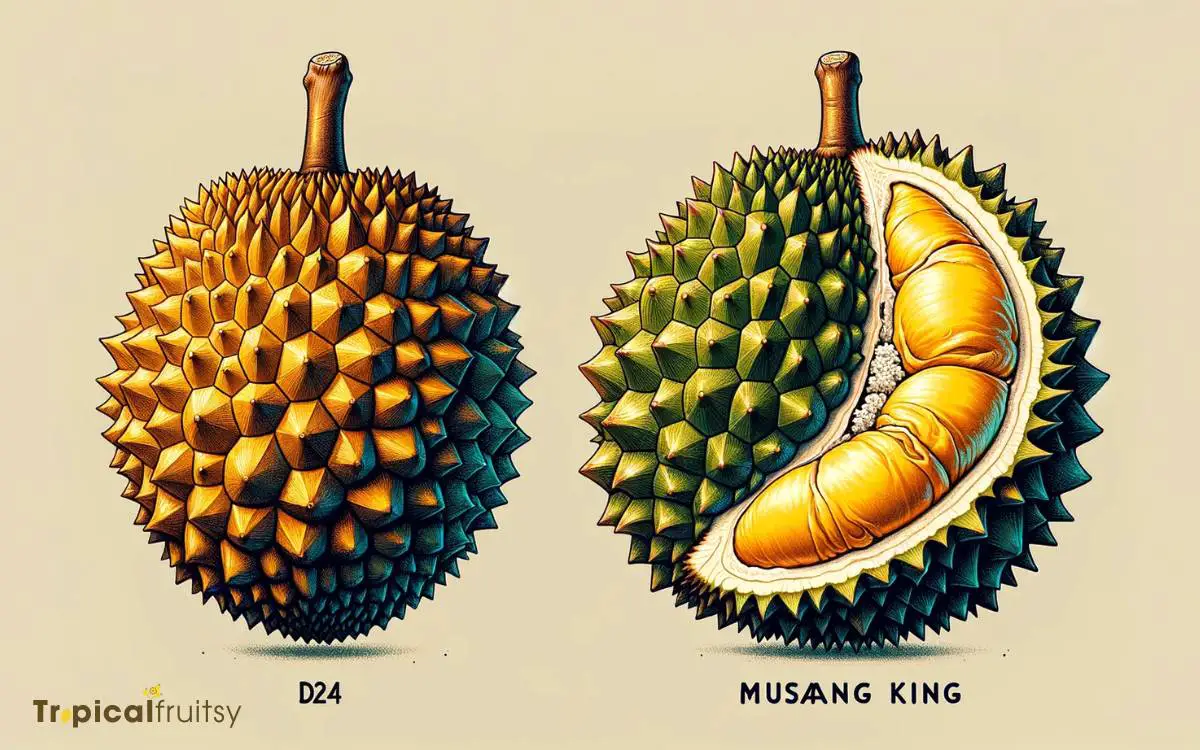
Key Takeaway
Comparison of D24 Durian and Musang King Durian
| Aspect | D24 Durian | Musang King Durian |
|---|---|---|
| Flavor | Bittersweet, less intense | Intensely sweet with a bitter edge |
| Texture | Creamy but firmer | Custard-like, very creamy |
| Nutritional Value | High in carbohydrates and vitamins | Comparable, with slight variations |
| Seasonal Availability | Peak seasons vary by region | Usually available June – August |
| Market Price | Generally more affordable | Premium pricing, often more expensive |
| Popularity | Once the most popular, now surpassed | Currently the most sought-after |
Origins of D24 and Musang King
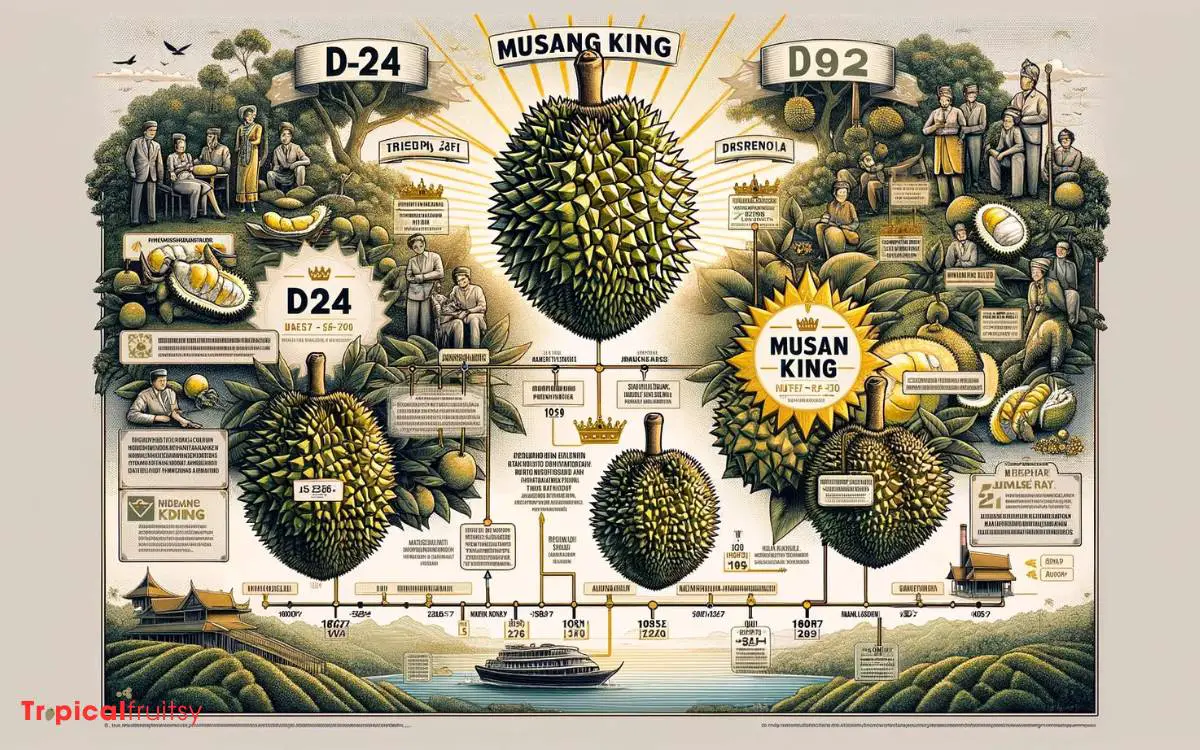
The D24 durian, also known as Sultan, emerged as a popular cultivar in Malaysia during the 1920s. It quickly garnered a following among durian enthusiasts due to its robust flavor profile and creamy texture.
The cultivation of D24 spread, reflecting its agronomic success and commercial viability within the region.
On the other hand, Musang King, known locally as Raja Kunyit, traces its royal lineage to the 1990s in Malaysia. Its inception into the durian market was transformative.
Musang King is characterized by its distinct golden flesh and exceptionally rich taste, which elevated it to a luxury status.
The divergence in the historical emergence of D24 and Musang King reflects not only the evolution of consumer preferences but also the advancements in horticultural practices within Malaysia’s agrarian landscape.
Flavor Profile Comparison
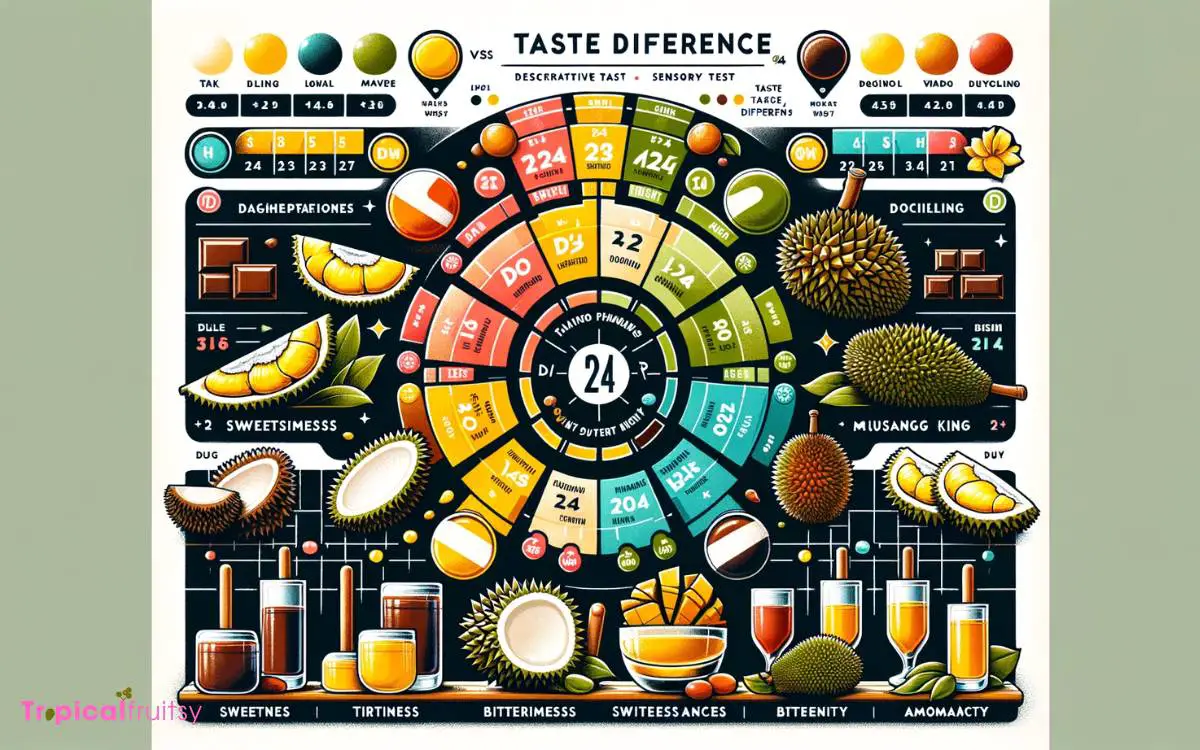
Moving to the realm of sensory analysis, the D24 and Musang King durians present distinct flavor profiles that can be dissected based on taste intensity, sweetness level, and aroma differences.
The D24 variety is often heralded for its moderately strong taste and creamy sweetness, characteristics that make it a revered choice among durian enthusiasts.
On the other hand, the Musang King is distinguished by its potent flavor that strikes a complex balance between sweet and bitter notes, accompanied by a robust and commanding aroma that sets it apart from other cultivars.
Taste Intensity
Within the realm of durian connoisseurship, the taste intensity of D24 and Musang King varieties exhibits distinct and robust flavor profiles that set them apart.
Experts often evaluate these profiles on several sensory dimensions:
D24 Durian:
- Bitterness: Often milder than Musang King, providing a more approachable experience for novices.
- Sweetness: Exhibits a rich, creamy sweetness with subtle complexities.
- Aftertaste: Less persistent aftertaste compared to Musang King, making it less overwhelming.
Musang King:
- Bitterness: More pronounced, with a complexity that aficionados cherish.
- Sweetness: Intense, almost overpowering, with layers of depth.
- Aftertaste: Lingering and potent, it leaves a memorable impression on the palate.
The Musang King’s flavor is generally more powerful and persistent, appealing to seasoned durian lovers, while the D24 offers a milder, yet still flavorful, alternative.
Sweetness Level
Although both D24 and Musang King durians are celebrated for their sweetness, the latter exhibits a more intense sugariness that can be described as almost cloying, contrasting with the former’s subtler and creamier sweetness profile.
The Musang King’s flavor is often characterized by a powerful, syrupy sweetness that permeates the palate, leaving a persistent aftertaste that aficionados find divine.
This heightened sweetness is accompanied by complex, fruity notes and a hint of bitterness that enhances its richness.
Conversely, D24 presents a more balanced sweetness, not as overwhelming, allowing for nuances of its flavor to emerge gracefully.
It carries a buttery texture with a subdued sweetness that some might find more approachable, especially those who are new to durian or prefer a less aggressive flavor profile.
Aroma Differences
When comparing the aromas of D24 and Musang King durians, the latter is distinguished by its potent and complex fragrance, often described as a unique blend of sweet and savory notes.
The scent profile of these two durian varieties can be dissected as follows:
D24 Durian Aroma:
- Milder Intensity: Less pungent than Musang King, approachable for new durian consumers.
- Sweetness-Oriented: Exhibits a simpler sweet aroma with faint bitter undertones.
- Less Complexity: The aroma is straightforward without the depth found in Musang King.
Musang King Aroma:
- Pungent and Pronounced: Recognizable immediately with a strong olfactory presence.
- Rich Blend: Melds sweet, creamy, and savory notes with occasional hints of bitterness.
- Multi-Layered Complexity: Offers an evolving scent profile that can appeal to connoisseurs.
The nuanced differences in aroma pave the way for a discussion on the texture and creaminess of these durian cultivars.
Texture and Creaminess
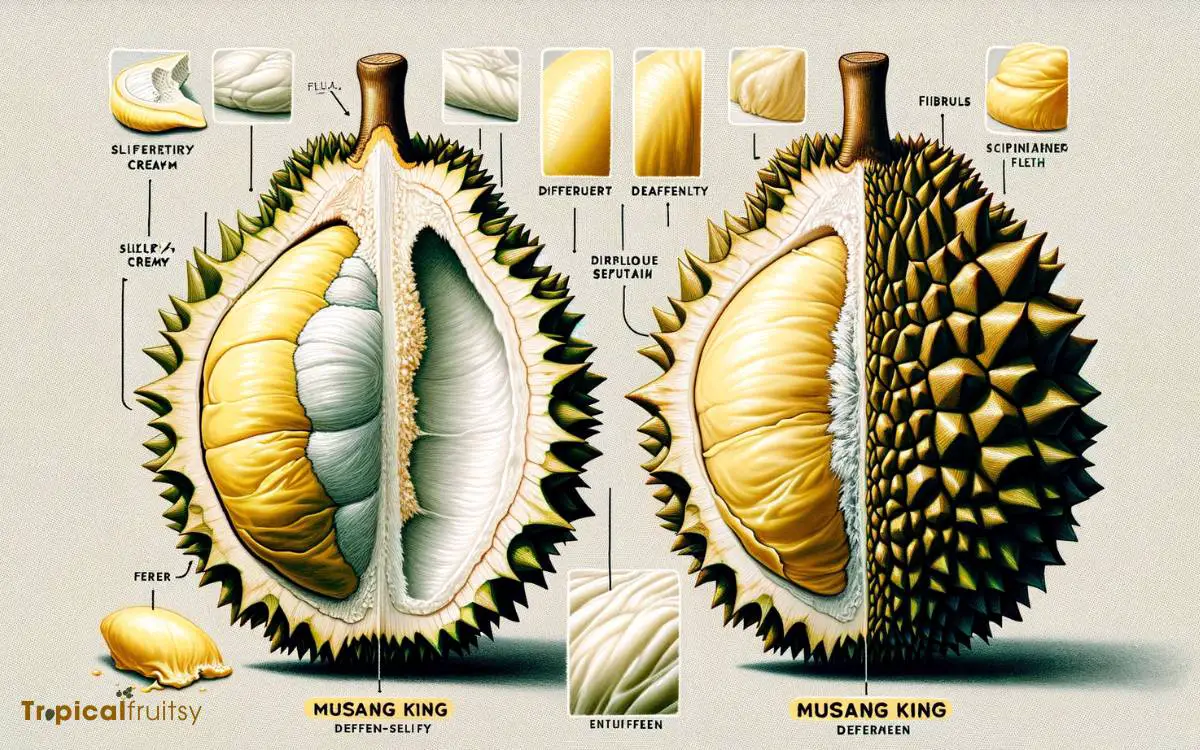
Regarding the texture and creaminess, D24 Durian typically presents a slightly firmer bite compared to the Musang King’s famously rich and velvety consistency.
The sensory experience of each durian variety is distinct, with the D24 offering a chewier texture which might appeal to those who prefer a more pronounced bite in their fruit.
On the other hand, the Musang King is renowned for its buttery smoothness that seems to dissolve effortlessly on the palate, a testament to its superior creaminess.
To further elucidate the differences, consider the following comparative table:
| Aspect | D24 Durian | Musang King |
|---|---|---|
| Texture | Slightly firm | Velvety smooth |
| Creaminess | Moderately creamy | Exceptionally creamy |
| Mouthfeel | Chewy bite | Melts in the mouth |
| Consistency | Dense and substantial | Soft and spreadable |
| Preference | For those who like texture | For creaminess lovers |
Each durian’s texture and creaminess level contributes significantly to its overall sensory profile and influences consumer preference.
Nutritional Value Breakdown
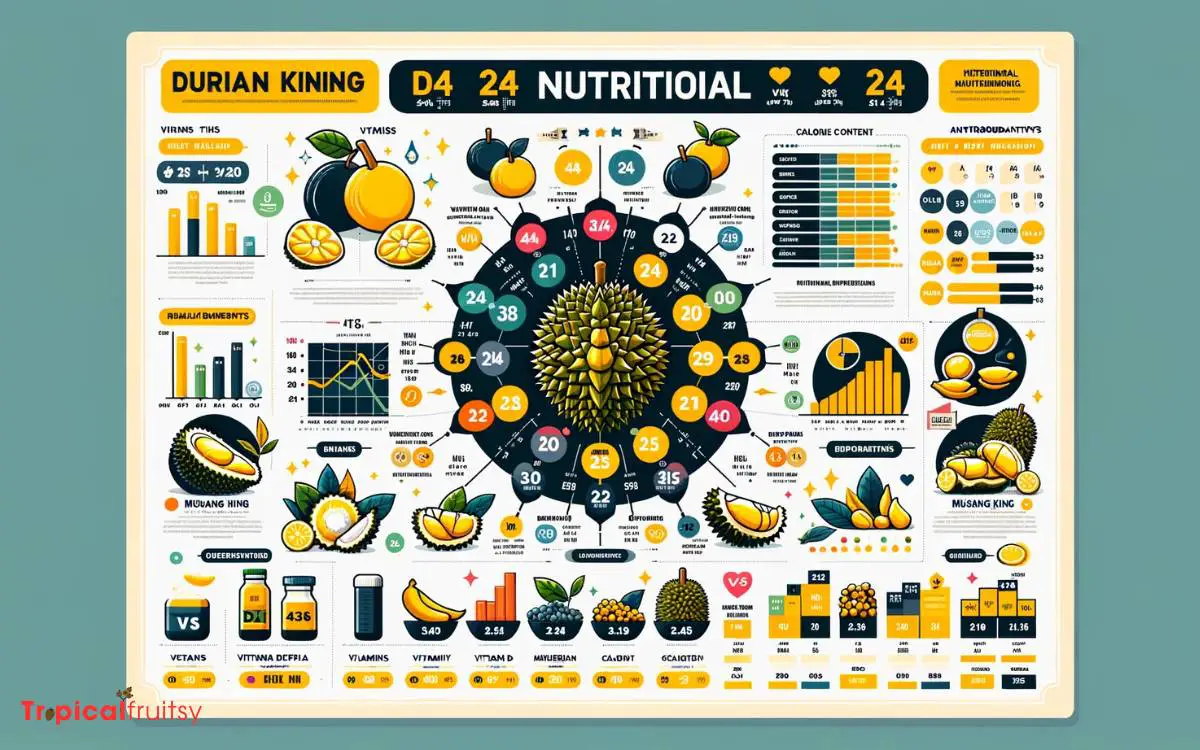
Both D24 and Musang King durians provide a wealth of nutrients, each offering a unique profile of vitamins, minerals, and dietary fiber.
To comprehensively compare their nutritional value, it is imperative to analyze:
Macronutrient Content
- Calories: D24 has slightly fewer calories compared to Musang King.
- Fats: Both contain heart-healthy monounsaturated fats.
- Proteins: Comparable levels, contributing to muscle maintenance.
Vitamin and Mineral Composition
- Vitamin C: High in both, supporting immune function.
- Potassium: Essential for heart and muscle function.
- Thiamin: Contributes to the body’s energy production processes.
Dietary Fiber
- Digestive Health: Fiber aids in digestion and regularity.
- Satiety: Helps in feeling full, which can aid in weight management.
Analyzing these factors demonstrates that both the D24 and Musang King durians are not only indulgent but also nutrient-dense, each with attributes beneficial to health.
Seasonal Availability
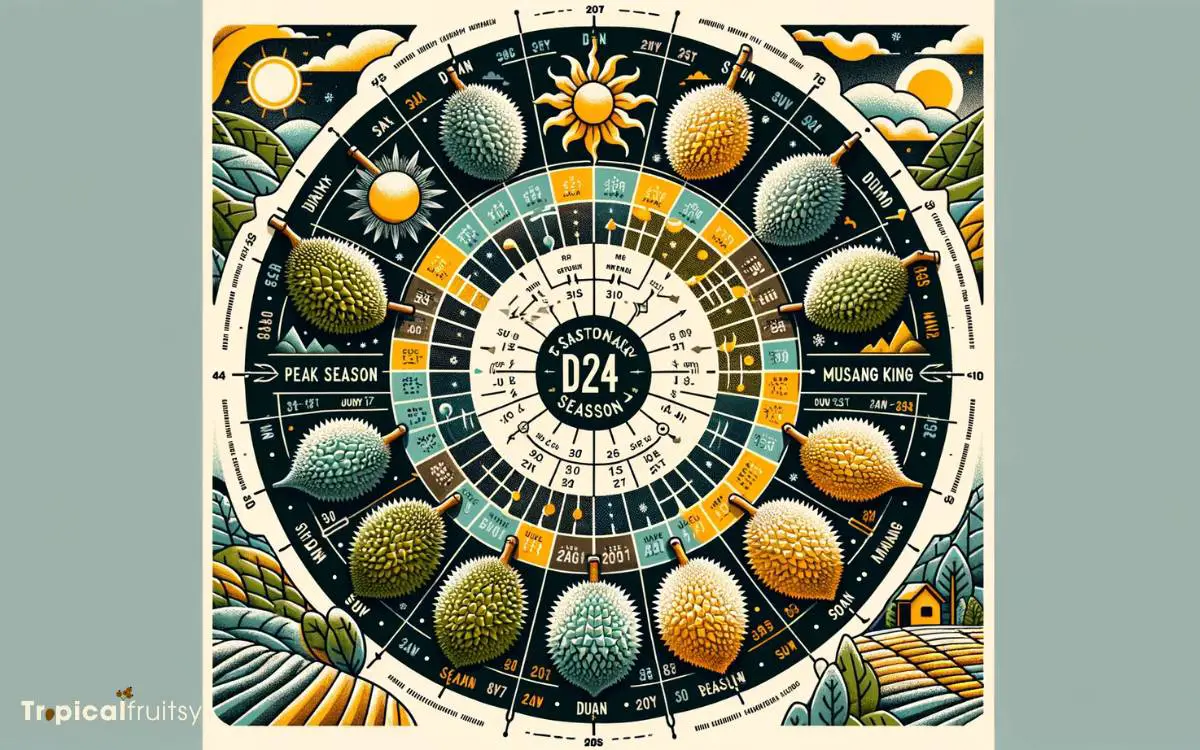
Understanding the seasonal availability of D24 and Musang King durians is crucial for consumers seeking to enjoy these fruits at their peak freshness.
The D24 variety, once the pinnacle of durian luxury, has a broader seasonal window, typically found from June to August, aligning with the general durian season in Malaysia.
On the other hand, the esteemed Musang King, known locally as ‘Durian Raja Kunyit’, has a more limited season.
Its prime availability is from June to July, with a possible shorter second season later in the year, depending on weather conditions. Connoisseurs and enthusiasts prioritize this period for its optimal flavor and texture.
Market availability of these durians is subject to regional climate variations, which may shift the expected seasons slightly.
Market Price Analysis
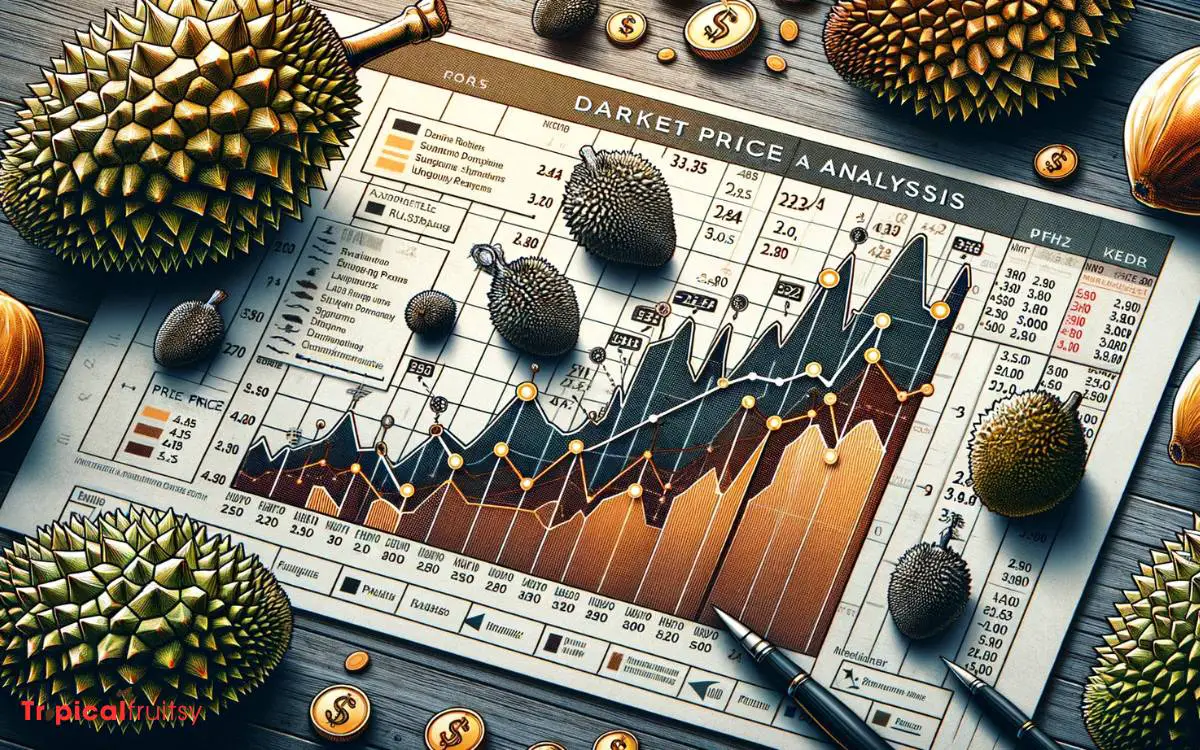
In assessing the market dynamics of D24 and Musang King durians, it is critical to consider the factors contributing to price fluctuations.
The interplay between demand and supply is pivotal in shaping the pricing landscape, where consumer preference and harvest yields exert significant influence.
A nuanced analysis will reveal how these elements differentially impact the cost of each durian variety, providing insights into their respective market positions.
Price Fluctuation Causes
While the demand for premium durians such as D24 and Musang King generally drives their market prices, several factors including seasonal yield, export market dynamics, and production costs contribute to their frequent price fluctuations.
Seasonal Yield
- Climatic conditions affecting harvest volume
- Natural events (e.g., droughts, floods) impacting fruit quality
Export Market Dynamics
- International demand variability
- Trade regulations and tariffs influencing accessibility
Production Costs
- Fluctuations in labor and input costs
- Investments in sustainable farming practices
Demand Vs. Supply Impact
The durian market’s price dynamics hinge on the intricate balance between the supply of D24 and Musang King varieties and the consumers’ insatiable demand for these fruits.
Market price analysis reveals that seasonal fluctuations, regional availability, and export demand significantly impact the price.
The supply chain, from growers to distributors, adapts to these shifts to meet the market’s needs and optimize profits.
| Factor | Impact on Price |
|---|---|
| Seasonality | Higher prices in off-season |
| Export Demand | Increased international demand raises prices |
| Crop Yield | Lower yield can lead to price spikes |
| Consumer Trend | Preference shifts may affect demand and price stability |
| Production Cost | Increases can be passed on to consumer prices |
Analyzing the supply and demand curve for D24 and Musang King, it’s apparent that these factors collectively dictate the market’s responsiveness, leading to price adjustments that align with the economic principle of equilibrium.
Popularity and Branding
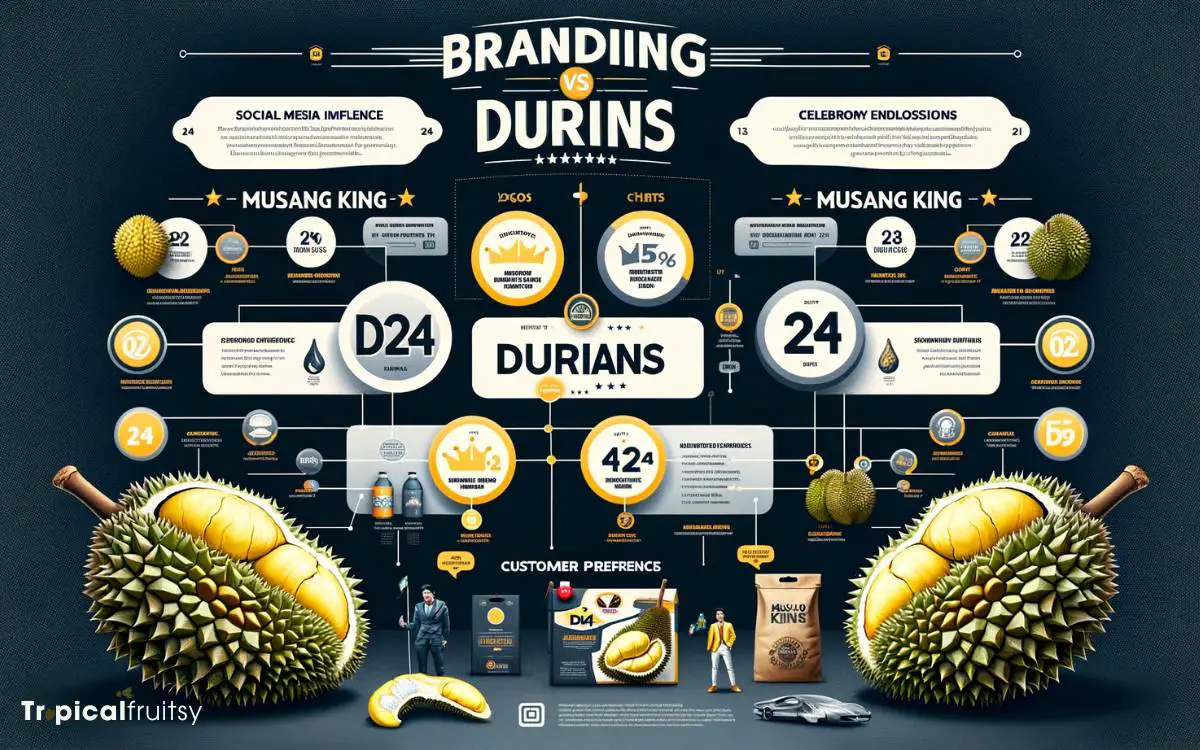
Both D24 and Musang King durians have garnered significant followings, yet the latter has achieved remarkable brand recognition, often being touted as the ‘king of fruits’ in Southeast Asia.
This title is not unwarranted, as Musang King stands out for its:
Brand Equity:
- Premium Positioning: Musang King is perceived as a luxury product.
- Consistent Quality: Consumers associate it with a richer taste and creamier texture.
- High Visibility: It’s heavily promoted in both domestic and international markets.
In contrast, the D24 variety, while respected, lacks the same level of branding prowess. Its subtler flavor and lower price point make it less of a status symbol but more accessible for a broader audience.
The branding strategies employed for Musang King have undeniably influenced its dominance in the market.
Red Prawn Durian Vs D24

Red Prawn Durian and D24 are two popular varieties of durians, each with distinct characteristics:
Red Prawn Durian (Ang Heh)
- Origin: This variety is primarily found in Malaysia, particularly in the state of Penang.
- Appearance: The Red Prawn gets its name from the deep orange-red color of its flesh. It has a smaller, more oval shape compared to some other varieties.
- Taste and Texture: The flesh is soft, creamy, and quite sticky. It’s known for its sweet taste, with a slightly complex, almost wine-like flavor profile. Some people detect a subtle bitter undertone.
- Aroma: It has a milder aroma compared to some other durian varieties.
- Season and Availability: It’s usually available in the mid to late durian season.
D24 Durian
- Origin: Also a Malaysian variety, D24 is widely available in many Southeast Asian countries.
- Appearance: The D24 has a more rounded shape with a relatively thick husk. The flesh is typically a pale yellow.
- Taste and Texture: The D24 is known for its rich and creamy texture, with a bittersweet taste that durian lovers often appreciate. It’s less sweet compared to the Red Prawn.
- Aroma: This variety has a stronger, more pungent smell, which is quite characteristic of durians in general.
- Season and Availability: D24 is one of the more readily available durians and often found throughout the durian season.
In summary, the choice between Red Prawn and D24 often comes down to personal preferences for sweetness, texture, and aroma.
Red Prawn is often recommended for those who prefer a sweeter, less pungent variety, while D24 is ideal for those who enjoy a more classic durian flavor with a balance of bitter and sweet notes.
Conclusion
D24 and Musang King durians present a rich tapestry of sensory experiences and nutritional profiles.
While the former is an esteemed predecessor in the durian lineage, the latter reigns supreme in contemporary preference.
The analysis of their flavors, textures, and market variables reveals a nuanced battleground, where Musang King often emerges as the gilded monarch.
Despite this, D24 retains a loyal following, securing its unshakeable root in the durian dynasty.

